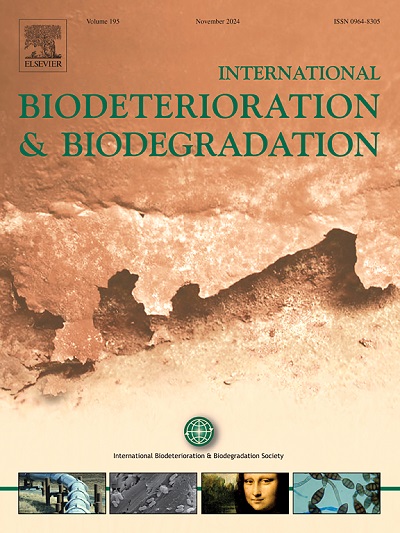通过可持续的补救方案对抗抗生素污染及其对环境的影响:当前的发展和挑战
IF 4.1
2区 环境科学与生态学
Q2 BIOTECHNOLOGY & APPLIED MICROBIOLOGY
International Biodeterioration & Biodegradation
Pub Date : 2025-07-27
DOI:10.1016/j.ibiod.2025.106166
引用次数: 0
摘要
抗生素广泛应用于医药、农业、水产养殖和畜牧业。近几十年来,全球处方和非处方抗生素的消费量大幅增加。由于生物体吸收不良,大量抗生素及其代谢物被排出并进入废水系统。此外,来自医疗设施、农业径流和制药工业的废水对环境抗生素污染也有很大影响。水生生态系统中抗生素的存在对人类健康和水生生物构成严重风险,即使是纳米或微克浓度。本文综述了抗生素的来源及其生态影响,包括抗生素耐药基因的传播和耐多药细菌的兴起。为了更好地了解环境持久性和相互作用,本文讨论了主要抗生素的分类和作用机制。该综述进一步探讨了旨在量化微量抗生素水平的先进检测方法,强调了针对特定抗生素类别的方法。在各种修复策略中,酶生物修复是一种非常有前途的解决方案。酶如β-内酰胺酶、漆酶和过氧化物酶被评估其降解各种抗生素类的功效。微生物修复涉及细菌和真菌在抗生素降解中的作用也进行了检查。通过整合对来源、影响、检测和补救技术的见解,本综述提供了抗生素污染的整体视角,并概述了减轻环境和公共健康风险的可持续途径。重要的是,这项研究强调了酶生物修复的高特异性和可扩展性,为推进可持续的抗生素去除技术提供了关键的路线图。本文章由计算机程序翻译,如有差异,请以英文原文为准。
Combating antibiotic pollution and its impacts on the environment through sustainable remediation options: Current developments and challenges
Antibiotics are extensively used in medicine, agriculture, aquaculture, and animal husbandry. Over recent decades, global consumption of both prescribed and unprescribed antibiotics has surged significantly. Due to poor absorption in living organisms, substantial amounts of antibiotics and their metabolites are excreted and enter wastewater systems. Additionally, effluents from healthcare facilities, agricultural runoff, and pharmaceutical industries contribute heavily to environmental antibiotic contamination. The presence of antibiotics in aquatic ecosystems poses serious risks to human health and aquatic life, even at nano- or microgram concentrations. This review offers a comprehensive analysis of antibiotic sources and their ecological impacts, including the dissemination of antibiotic resistance genes and the rise of multidrug-resistant bacteria. To better understand environmental persistence and interactions, the classification and mechanisms of action of major antibiotics are discussed. The review further explores advanced detection methods designed to quantify trace antibiotic levels, emphasizing approaches tailored to specific antibiotic classes. Among various remediation strategies, enzymatic bioremediation is highlighted as a highly promising solution. Enzymes such as β-lactamases, laccases, and peroxidases are evaluated for their efficacy in degrading diverse antibiotic classes. The role of microbial remediation involving bacteria and fungi in antibiotic degradation is also examined. By integrating insights into sources, impacts, detection, and remediation techniques, this review provides a holistic perspective on antibiotic pollution and outlines sustainable pathways to mitigate environmental and public health risks. Importantly, this study underscores enzymatic bioremediation's high specificity and potential for scalability, offering a critical roadmap for advancing sustainable antibiotic removal technologies.
求助全文
通过发布文献求助,成功后即可免费获取论文全文。
去求助
来源期刊
CiteScore
9.60
自引率
10.40%
发文量
107
审稿时长
21 days
期刊介绍:
International Biodeterioration and Biodegradation publishes original research papers and reviews on the biological causes of deterioration or degradation.

 求助内容:
求助内容: 应助结果提醒方式:
应助结果提醒方式:


